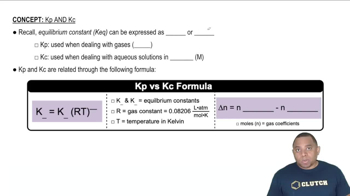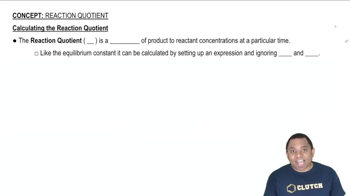This reaction has an equilibrium constant of Kp = 2.2⨉106 at 298 K. 2 COF2(g) ⇌ CO2(g) + CF4(g) Calculate Kp for each reaction and predict whether reactants or products will be favored at equilibrium.
c. 2 CO2(g) + 2 CF4(g) ⇌ 4 COF2(g)
 Verified step by step guidance
Verified step by step guidance



This reaction has an equilibrium constant of Kp = 2.2⨉106 at 298 K. 2 COF2(g) ⇌ CO2(g) + CF4(g) Calculate Kp for each reaction and predict whether reactants or products will be favored at equilibrium.
c. 2 CO2(g) + 2 CF4(g) ⇌ 4 COF2(g)
Consider the reactions and their respective equilibrium
constants:
NO(g) + 1/2 Br (g) ⇌ NOBr(g) Kp = 5.3
2 NO(g) ⇌ N2(g) + O2(g) Kp = 2.1⨉1030
Use these reactions and their equilibrium constants to predict
the equilibrium constant for the following reaction: N2(g) + O2(g) + Br2(g) ⇌ 2 NOBr(g)
Calculate Kc for each reaction. a. I2(g) ⇌ 2I(g) Kp = 6.26⨉10-22 (at 298K)
Calculate Kp for each reaction. a. N2O4(g) ⇌ 2 NO2(g) Kc = 5.9⨉10-3 (at 298 K)
Calculate Kp for each reaction.
b. N2(g) + 3 H2(g) ⇌ 2 NH3(g) Kc = 3.7⨉108 (at 298 K)
c. N2(g) + O2(g) ⇌ 2 NO(g) Kc = 4.10⨉10-31 (at 298 K)